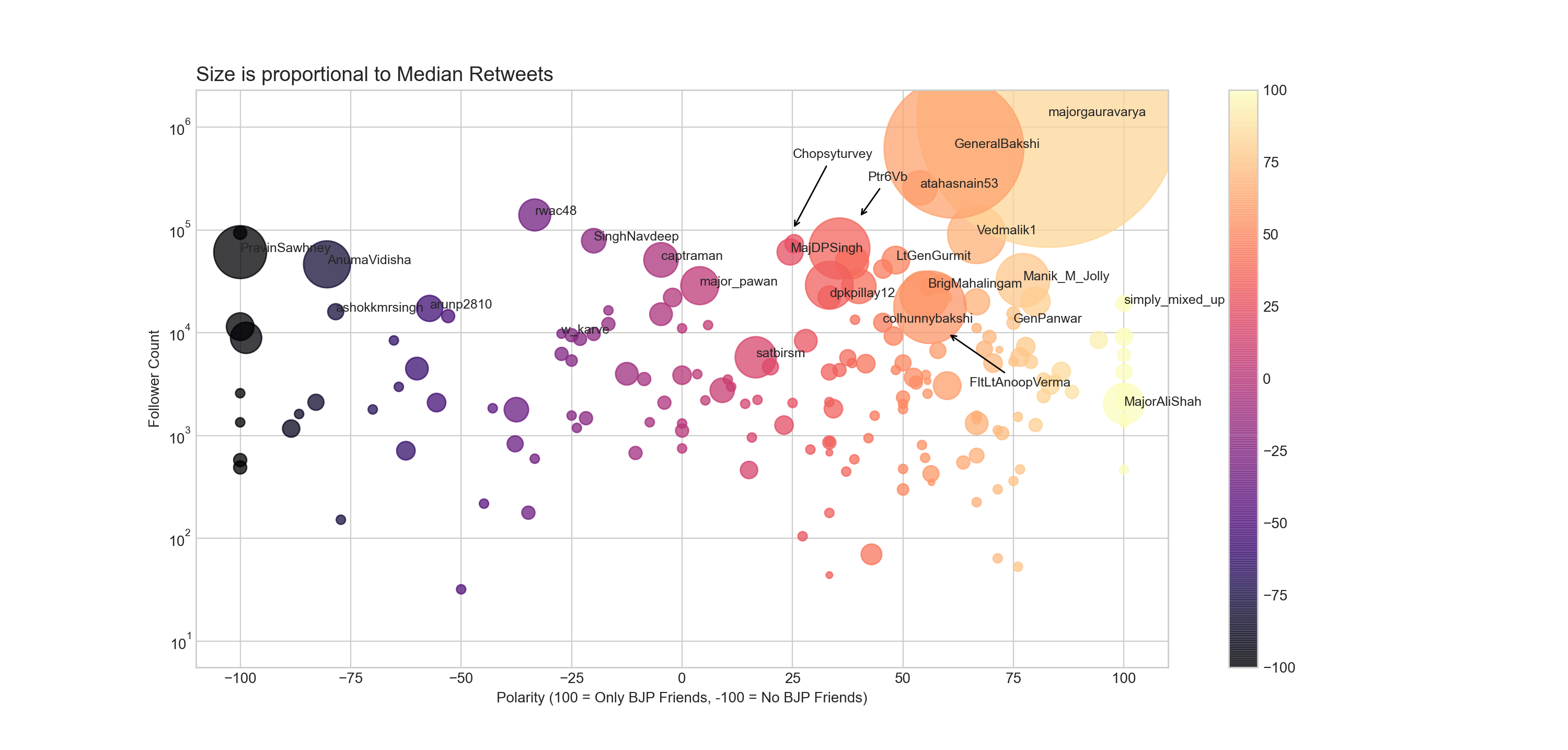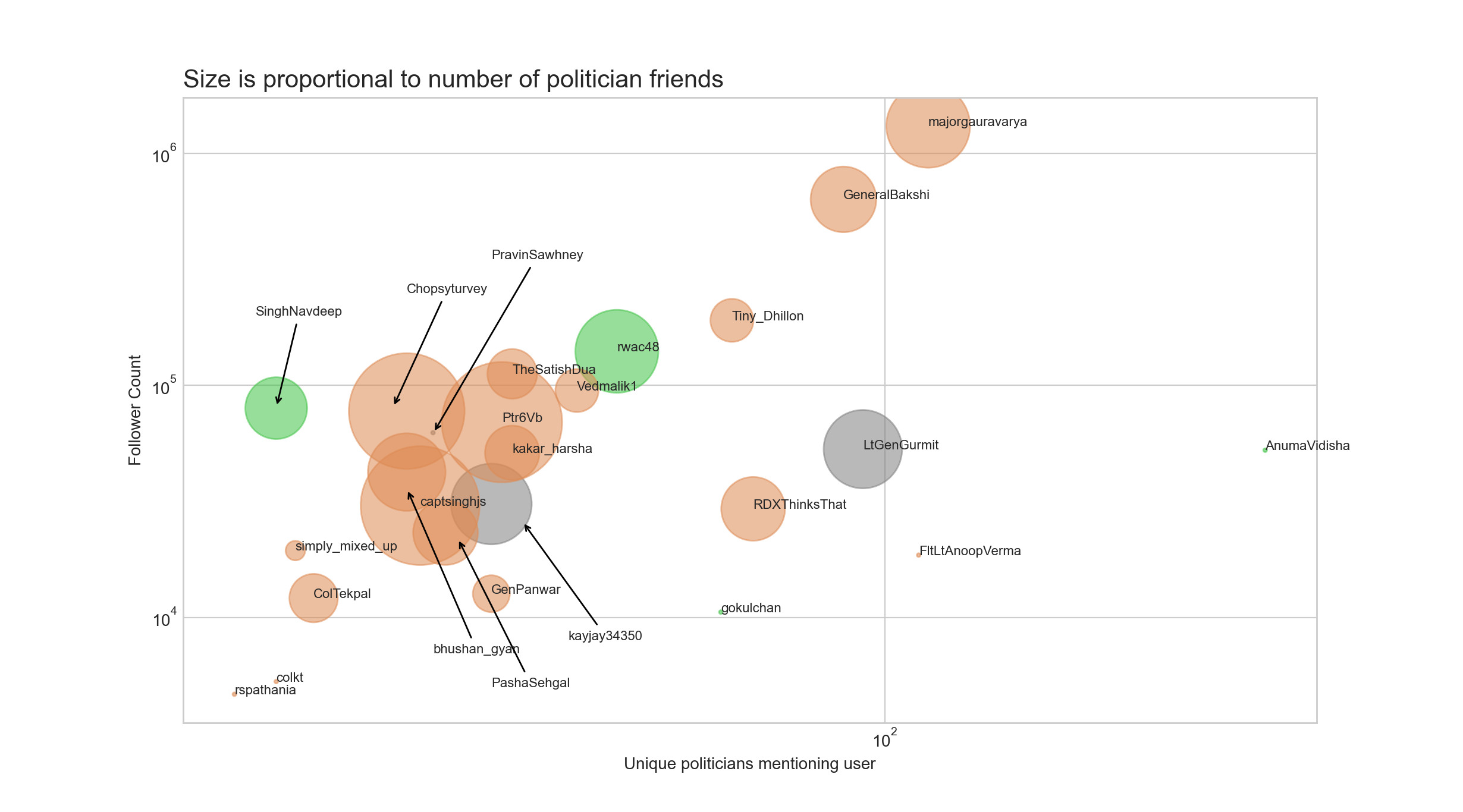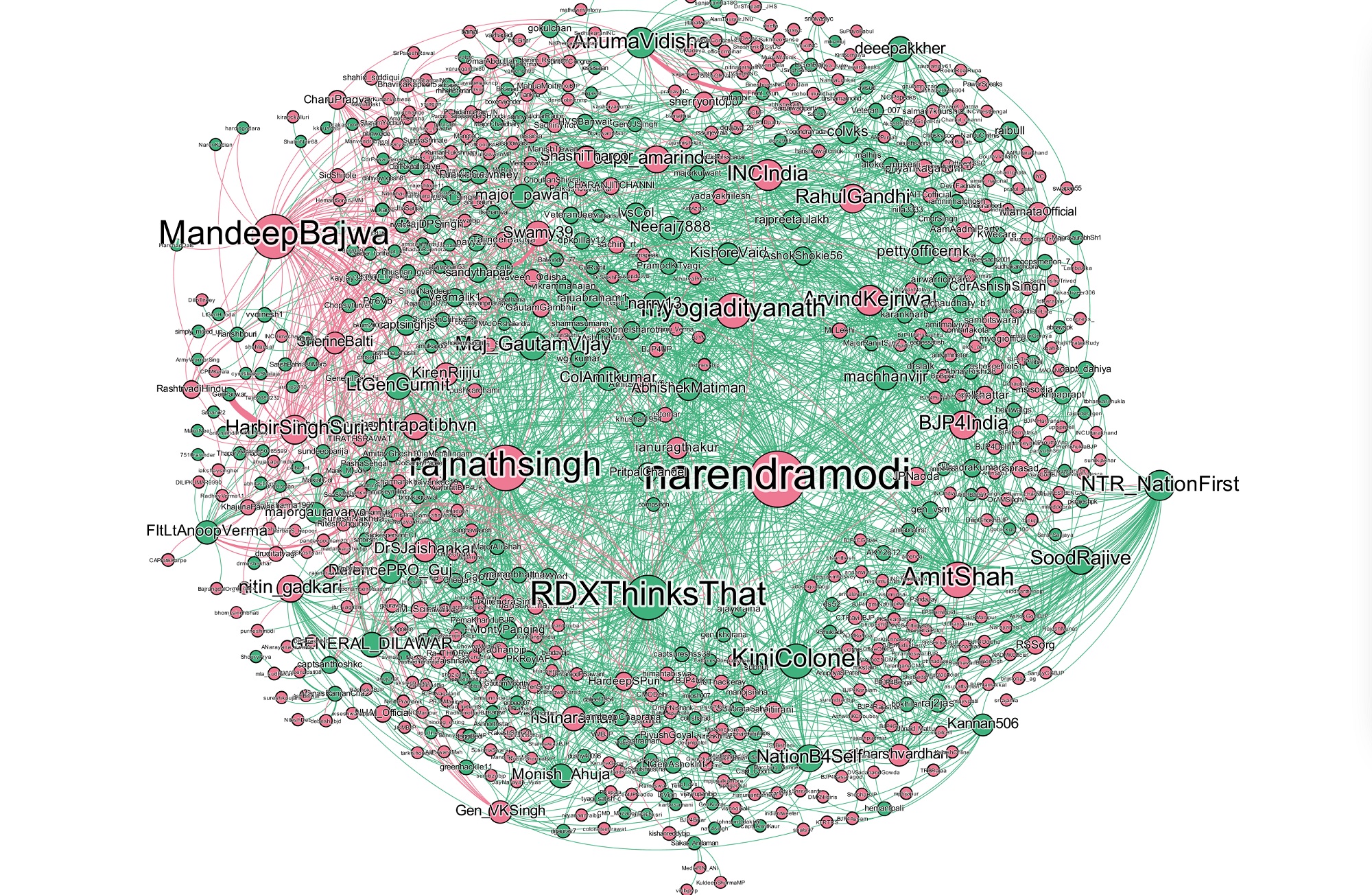Soham De, Agrima Seth, Joyojeet Pal
The military is one of the institutions that is held in extremely high esteem in modern nation-states around the world. While democratic states emphasize the separation of military and civilian leadership, the military is important in politics for several reasons. It is critical for politicians to appear supportive of the military as an institution, and for its components – soldiers. The military is seen widely as honest, disciplined, and benevolent, it is valued for sacrifice for the greater national good, and various public surveys have shown that the military remains the most trusted institution in the country – well above politicians, bureaucracy, and the police.
The functional value of support from politicians to the military may be through budgetary allocation and direct support for work conditions, alongside which there is symbolic support in the public discourse, such as politicians’ praise for soldiers and their service, monuments etc. This includes thoughtful inclusion of the military in politicians’ visual representation to the public – thus appearing at or alongside soldiers at places of conflict, taking part in military rituals, periodically signaling praise for the people in uniform, and showing concern or action during times of conflict that involve direct combat, physical risk, or casualties. In the opposite direction, the military’s relationship with civilian leadership is often fraught. While political parties may craft their branding as hawkish, or prioritizing the needs of, or attention to the military over other issues of national concern, the military must show loyalty to any elected civilian leadership. This is particularly true for serving members of the military, and the military establishment as a whole.
Although Indian democracy has seen a successfully maintained supremacy of civilian leadership over the military, and unlike most of its neighbouring states, has never seen a serious threat to elected representation by the military leadership, there has been a relationship between the military and politics through the movement of retired service persons into political life. India has had members in defence from politically important families who transitioned from pre-independence aristocracy or zamindari into military service. One of the country’s most important military-political connections has been that of Subhas Chandra Bose, who went from leading the Congress Party to being the head of the Indian National Army in the pre- independence period. His general, Shah Nawaz Khan was among the earliest people of military rank to move into politics by contesting a Lok Sabha seat and subsequently serving on several ministries. While military officers frequently moved into titular or foreign affair positions including governorships and embassies, the direct move into party politics remained relatively limited, unlike for instance in the US, where a large number of politicians (and presidents) had roots in the armed forces.
While the INCs two best known military officers turned politicians were Rajesh Pilot and Amarinder Singh, the BJP’s best known military import was Jaswant Singh, who was part of the party from its earliest days as Jan Sangh, while Bangladesh War Hero Gen. JS Aurora joined the Akali Dal post-retirement. While the Vajpayee era saw the joining of two key senior generals — BC Khanduri and JFR Jacob, however it was the Modi era that saw a huge expansion of the military starting with Rajyawardhan Rathore and VK Singh in the first Modi administration. Both were important figures and heroes in the public imagination – Rathore was a widely recognized Olympian, Singh was the former Chief of Army Staff and a participant in anti-corruption rallies alongside Yoga guru Ramdev, who joined the BJP in 2014. However, it was in the second Modi ministry that the military discourse was upped significantly. The Chowkidar handle was being used, as a direct shout out to security, the Balakot strikes had just happened, Sunny Deol had been added to the party with a celebration of his work in the war film Border.
While much has been written about the Modi government’s incorporation of a nationalist stance, which goes with the broader lionization of the military in political discourse, the direct engagement of military-related individuals as a component of that has not been adequately examined.
Cast of Characters
First, we take a look at the key people who are active on social media, how followed they are, and the extent to which they get engaged, as measured through their retweets. We plotted all the accounts of defence veterans identified in our study on a binary categorization – whether the politicians they follow belong to the ruling party (BJP) or any other national or regional political party. Thereafter, we mapped them based on the number of followers they have on Twitter, and visualized the average engagement they get to their tweets.
The single most influential defence-veteran account belongs to Maj. Gaurav Arya, who gets more engaged than any other veteran, but is also more polarized than any other veteran, almost exclusively skewed towards the ruling party. He is followed by Maj. Gen. GD Bakshi, Gen. VP Malik, and Lt. Gen. Vinod Bhatia. Arya is also important because he is the editor of Chanakya Forum, which is a military affairs magazine with a large following on its Twitter and YouTube channels.
The skew is most evident in our visualization of the 50 most followed defence-related accounts (excluding accounts that are already aligned with a political party such as V K Singh or accounts that do not publicly declare their military credentials such as TheSkinDoctor13)

Fig 1: Polarisation of self-asserted veterans (top-50) as inferred from their friend-lists
The figure (Fig 1a) above visualises the political polarisation of self-declared veterans on Twitter. Size of each bubble is proportional to the median retweet counts for these accounts in the Jan – Oct 2021 time period we are studying.
If we turn to who is being talked about, we see that the political account that defence veterans most frequently mentioned by far (on a log scale) is that of Narendra Modi. The prime minister’s account is by far the most followed and the most tweeted about account from among veterans. Since fig 2a is on a log scale, the extent of Modi’s dominance is not visually clear – he is almost twice as tweeted to as his nearest rival among defence accounts, which is that of Defence Minister Rajnath Singh. This shows the massive advantage that the BJP has over its nearest rival with regard to engagement from veterans.
We also see in figure 2(a) that there is a reciprocity involved in making connections in defence. We see for instance that while PM Narendra Modi’s account gets most engaged, he also “follows” (of “friends”) a substantial number of accounts of veterans (size of the bubble). The only politician among the major national figures who follows more self-described defence veterans is Defence Minister Rajnath Singh. We see for instance INC leader Rahul Gandhi trails significantly both in the level of engagement by defence veterans, but in turn, his account does not engage a lot of defence veterans through following either. In fact, Yogi Adityanath, who is a state Chief Minister, gets more engaged by defence veterans that Gandhi or even Nirmala Sitharaman, the former defence minister.

Fig 2(a): Most-mentioned politicians. Orange = BJP, Green = INC, Blue = Other Parties or Official accounts. The size of the bubble is proportional to the number of tweets (including RTs) made by that account in the period of study (general tweeting activity of the account)
When we turn to the defence veteran accounts that get the most mentions or callouts by politicians, first, we see that the top players are overwhelmingly BJP-leaning. This means that more politicians from the BJP are likely to call out to defence-related accounts. This also underlines a reason for the dominance of the BJP in this space. We again see here that @majorgauravarya and @GeneralBakshi are highly engaged. There are two important outliers. Former Wing Cdr Anuma Acharya (@AnumaVidisha) is one account that is openly pro-INC, and tends to get heavily engaged by the party, but the majority of engagements with her account are from lower-level cadre politicians, and through a very systematic style of mass messaging that suggests that party members expect that she will amplify their messaging, and give it the legitimacy of being from the account of a military veteran. A similar pattern is seen with @GenPanwar, who also gets a high scale of mentions, but from a small number of lower-level BJP politicians.
A consistent and vocal set of very senior retirees from the military who have both significant social media following and appear on the news include Some of the most important and influential accounts include Maj Gen. GD Bakshi (@GenBakshi), Col. Rohit Dev (@RDXThinksThat), Lt Gen. KJS Dhillon (@tiny_dhillon), Air Marshall Anil Chopra (@chopsyturvey), Lt. Gen. Vinod Bhatia (@Ptr6Vb), Lt. Gen. Satish Dua (TheSatishDua), all of whom are tweeted to or mentioned by ruling party politicians.
The two key military figures who tend not to be preferred by the ruling party politicians are Lt. Gen HS Panag (@rwac48), who joined the Aam Aadmi Party (AAP) and went on record openly criticized the Indian army’s action during an event of Kashmiri citizen tied as a human shield by the military, and Maj. Navdeep Singh (@singhnavdeep) who is a veteran who has spoke significantly on legal issues related to the military. In general, even accounts like @ColTekpal, which are generally opposed to the dispensation of the current government, tend to be more followed by BJP politicians. This suggests that overall, the BJP is more decisive about having politicians follow defence veterans and mention them. As we see, however, the numbers overall are small. The overwhelming majority of even the most significant defence accounts have less than 100 politicians referring to them through the entire study period.

Fig 2(b): 25 most-mentioned defence accounts
The major peak has been more recent, the war on Ukraine, which has not only brought a number of military personnel offering professional opinions, but has in turn been a means for mainstream media engagement with defence through appearances on television debates etc. To look closer at the topics that drive defence persons’ engagement with Twitter, we mapped the key events in the study period and found four points when social media activity peaked. These were
2021-09-17: During Prime Minister Narendra Modi’s birthday when veterans wished him
2021-04-27: During the COVID 2nd wave panic, with veterans messaging politicians for oxygen and criticizing 5-star hotel in Delhi to COVID centers for HC judges
2021-08-07: During military Junior Commissioned Officer Neeraj Chopra’s Olympic gold victory
2021-05-02: During the state election losses faced by the BJP in West Bengal and Kerala

Fig 3: Timeline of Politician and Defence Mentions over Jan – Oct 21.
One important pattern in the discourse, that of nationalism, is seen in the way certain issues are framed. One issue of frequent discussion for veterans was borders and security. The 1971 Bangladesh War remains the most popular galvanizing event across several key stakeholders. For one, many of the retired officers, especially the more senior officers, personally knew individuals associated with the event. The image of the respective Indian and Pakistani commanders – Lt. Gen. JS Aurora (who would eventually join the Akali Dal) and Lt. Gen. AAK Niazi signing the instrument of surrender in Dhaka has become the iconic image of the military outcome of the war. This image was widely used by veterans, who interestingly do not mention Indira Gandhi as much (or at all).
Finally, we mapped the network connections between the politicians and the defence veterans. The network graph here shows the frequency of engagement between politicians and defence personnel. In a nutshell, this shows that the defence veterans (green bubbles) engage a lot with politicians (green lines), whereas in general, the politicians (red bubbles) have limited functional engagement with defence veterans (red lines). Thus the overwhelming majority of lines are green – ie a defence veteran is mentioning a politican for some reason, and only a fraction of engagements are red lines, ie a politician reaching out to a defence veteran.

Fig 4: Network graph visualization politicians (in pink) and defence-related accounts (in green). A green edge between 2 nodes implies a tweet from a defence veteran mentioning a politician and vice-versa. The key takeaway here is that defence veterans reach out to politicians indiscriminately and more frequently, while politicians only mention a small subset of these defence accounts. The interaction is therefore, not bi-directional.
Methodology & Data
To study interactions between self-described defence-related accounts and politicians on Twitter, we aggregate separate lists of these accounts. We borrow the list of politicians from prior work (NivaDuck) that was developed to identify politicians on Twitter in a given country. Starting with a random sample of manually curated Twitter handles of Indian politicians, this database was built by iteratively identifying politicians based on the profile description text and tweet content. We used the NivaDuck database of political actors in India (~30,000 politicians) for this.
We borrow our database of influencers and journalists from prior work (DISMISS) – a database of Indian Influencers on Twitter, which was also curated by a method similar to that of Nivaduck.
Using a similar methodology, we build the defence database by iteratively collecting friends of friends of 15 manually selected defence-related accounts. From them, we search for defence-related terms such as `army’, `navy’, `General’, `Major’, ‘Lieutenant’ etc from their Twitter descriptions and remove the ones without such mention. These defence-related words were manually selected from the most-frequently occurring words in the description texts of the 1000 most-recently followed accounts for all the 15 seed accounts. The final resulting 1300 accounts were manually classified into four categories – (a) official; these were the accounts belonging to the official organizations of the Indian defence forces, (b) self-asserted veterans; these were the accounts belonging to individuals who claim to have served the Indian defence forces, (c) related to defence; these were the accounts belonging to individuals who claim to be related to those who served the defence forces, i.e., spouse, parents or children and (d) others; these were the accounts belonging to individuals who claim to be analysts, content aggregators, fan pages, etc.